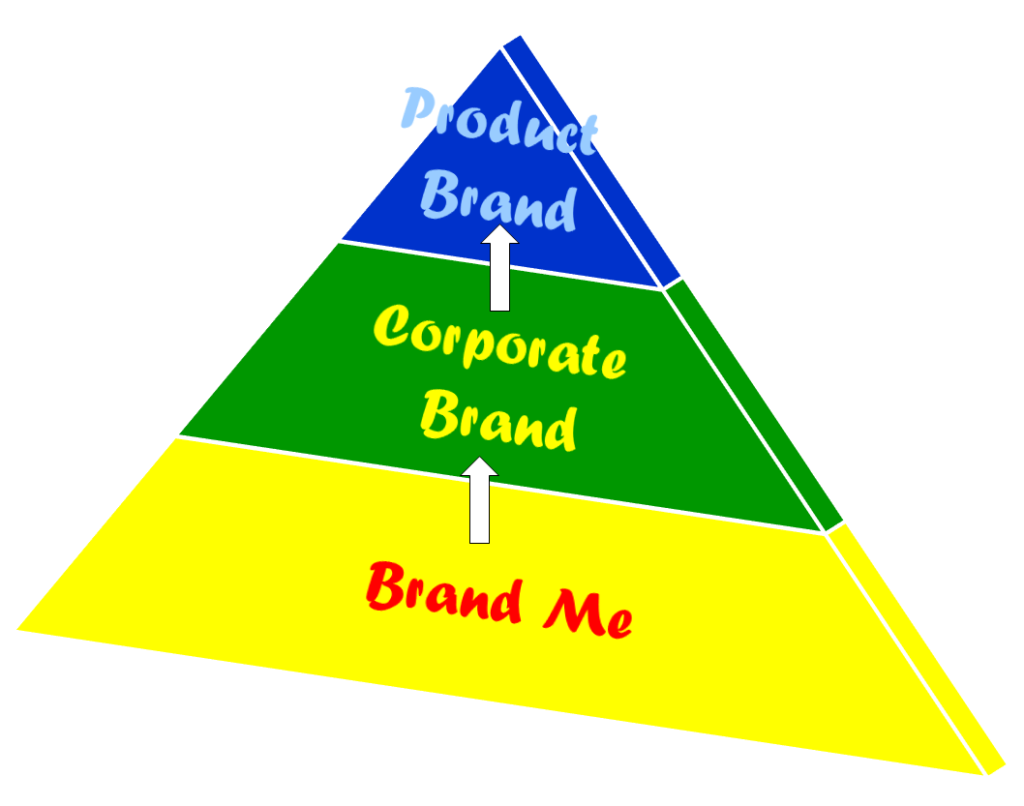The Power of “BRAND ME” in Pharmaceutical Branding: A Strategic Imperative for District Managers and Brand Managers
Authors – Shailaja Dwivedi Pathak and Vivek Hattangadi

Introduction
In the highly competitive and trust-driven pharmaceutical industry, branding goes beyond just product marketing—it is about building credibility, expertise, and emotional connections.
While corporate and product brands are critical, the foundation of strong branding often lies in the personal brands of customer-facing employees – Medical Representatives, District Managers and Brand Managers
This concept, known as “BRAND ME,” suggests that when individuals within an organization cultivate their personal brands, the corporate and product brands naturally flourish.
For pharmaceutical brand managers in India, where relationships and trust play a pivotal role in prescribing behavior, leveraging “BRAND ME” can be a game-changer. This essay explores why personal branding matters, how it strengthens pharmaceutical branding, and actionable strategies for brand managers to foster a culture of strong individual and collective branding.
Why “BRAND ME” Matters in Pharma
1. Trust is the Currency of Pharma Branding
Unlike FMCG or tech products, pharmaceutical brands rely heavily on trust. Doctors prescribe medicines based on confidence in the company, the scientific data, and—most importantly—the people representing the brand. When Medical Representatives and District Managers, and Brand Managers have strong personal brands, they amplify the credibility of the brands they promote.
2. The Human Element in a Digital World
Even with digital transformation, pharma remains a relationship-driven industry. Doctors prefer engaging with knowledgeable, reliable, and personable Medical Representatives, District Managers. Medical Representatives and District Managers with a strong “BRAND ME” — are seen as experts, problem-solvers, and trusted advisors — will always outperform those who are generic.
3. Employee Advocacy Strengthens Corporate Branding
When Medical Representatives and District Manager’s actively build their personal brands, they become organic advocates for the company. A doctor who trusts Medical Representatives and District Manager’s insights will extend that trust to the company’s brands. Similarly, a KOL who is also a strong personal brand influencer can shape market perceptions more effectively than traditional advertising.
How “BRAND ME” Enhances Pharma Branding
1. Seamless Product Brand Building
When customer-facing employees like Medical Representatives and District Managers have established credibility, introducing new products becomes easier. Doctors are more receptive to suggestions from Medical Representatives and District Managers they respect. For instance, if a Medical Representative is known for providing valuable insights on diabetes management, their endorsement of a new anti-diabetic drug carries more weight.
2. Differentiation in a Crowded Market
India’s pharmaceutical market is saturated with generics and me-too brands. A strong “BRAND ME” helps differentiate not just the individual but also the products they represent. Medical Representatives and District Managers known for in-depth knowledge or a KOL recognized for cutting-edge research brings uniqueness that pure marketing cannot replicate.
3. Crisis Resilience
In times of controversy (e.g., drug recalls or negative publications), a company with strong personal brands within its ranks can better manage reputation risks. Trusted Medical Representatives, District Managers and Brand Managers can communicate authentically, mitigating damage more effectively than corporate statements alone.
Strategies for Pharma District Managers and Brand Managers to Foster “BRAND ME”
1. Encourage Personal Branding Among Medical Representatives, District Managers and Brand Managers
– Training & Development: Equip Medical Representatives and District Managers with skills beyond sales—scientific knowledge, soft skills, and digital presence (LinkedIn, Twitter).
– Content Empowerment: Provide reps with shareable, value-added content (clinical summaries, infographics) that they can personalize and distribute.
– Recognition Programs: Highlight and reward Medical Representatives and District Managers who build strong professional reputations, making them internal role models.
2. Leverage KOLs as Personal Brand Ambassadors
– Collaborative Content: Co-create articles, webinars, and research papers with KOLs, enhancing their authority while associating them with your brand.
– Social Media Synergy: Encourage KOLs to share insights about your brands in their own voice, making promotions more authentic.
3. Build a Culture of Expertise & Thought Leadership
– Internal Knowledge Hubs: Create platforms where Medical Representatives and District Managers can contribute insights (e.g., internal blogs, discussion forums).
– External Speaking Opportunities: Sponsor Medical Representatives, District Managers and Brand Managers to speak at conferences, reinforcing their (and your brand’s) authority.
4. Integrate Digital & Offline Branding
– LinkedIn Branding for Teams: Train them on professional LinkedIn usage—sharing industry trends, engaging with HCPs, and positioning themselves as experts.
– Hybrid Engagement: Combine digital touchpoints (webinars, emails) with traditional face-to-face interactions for a holistic branding approach.
Case Study: Successful “BRAND ME” in Dr. Almaaz Pharmaceuticals (name changed for confidentiality) a transnational Indian Pharma company
Example: Almaaz Pharmaceuticals, a leading Indian pharma company encouraged its Medical Representatives and District Managers to build LinkedIn profiles where they shared quick clinical insights, patient success stories, and product updates with active help from Brand Managers.
Over time, doctors began recognizing these Medical Representatives and District Managers as knowledgeable resources rather than just salespeople.
When Almaaz Pharmaceuticals launched a new cardiology drug, the credibility, reliability and trustworthiness of Medical Representatives and District Managers existing credibility led to faster adoption compared to competitors relying solely on traditional detailing.
Expanding “BRAND ME” in Pharma: Digital Branding and KOL Engagement
1. Digital Branding of Medical Representatives, District Managers and Sales Teams
Why Digital Personal Branding Matters in Indian Pharma
With doctors increasingly engaging on platforms like LinkedIn, Twitter (X), Instagram and even WhatsApp, Medical Representatives and District Managers who build a strong digital presence gain a competitive edge. However, pharma branding in India must balance compliance (as per UCPMP guidelines) with authenticity.
Actionable Strategies for Medical Representatives and District Managers
A. LinkedIn as a Professional Authority-Builder
The two authors have always been talking about Medical Representatives being transformed into Knowledge Workers and District Managers as their leaders. How can you do that?
– Optimize Profiles: Encourage Medical Representatives and District Managers to use professional headshots, keyword-rich profiles in LinkedIn (e.g., “Cardiology Specialist at Almaaz Pharma), and regular activity updates taking active help from Brand Managers.
Share Value-Driven Content
– Clinical insights (e.g., “New RSSDI (Research Society for the STUDY IF Diabetes in India) guidelines on SGLT2 inhibitors in CKD”).
– Case studies (with anonymized patient success stories).
– Industry trends (e.g., “How AI is shaping diabetes care in India”).
– Engage with HCPs Thoughtfully: Comment on doctors’ posts with scientific insights rather than sales pitches.
Example: At Almaaz Pharmaceuticals a Mumbai-based Medical Representative and her District Manager specializing in oncology built a LinkedIn presence by summarizing key ASCO (The American Society of Clinical Oncology) updates. Over time, oncologists began recognizing them as a knowledge source, leading to higher engagement during field visits.
B. WhatsApp for Relationship Nurturing (Compliantly)
– Private Groups for HCPs: Create small groups (e.g., “Cardiology Insights – Delhi NCR”) where reps share approved content like journal summaries or webinar invites.
– Personalized Follow-ups: Instead of bulk forwards, Medical Representatives and District Managers can share customized messages (e.g., “Dr. Sharma, this new RCT aligns with our discussion last week”).
Caution: Actively and explicitly seek permission from doctors before you begin an e-mail or WhatsApp marketing. Permission marketing is a strategy where you obtain explicit consent from doctors before sending them promotional or informational content. In the pharmaceutical industry, this is especially critical due to strict regulations and ethical considerations. Permission marketing in pharma ensures trust, compliance, and higher engagement. Always prioritize consent, relevance, and legal adherence in email and WhatsApp campaigns.
C. AI Tools for Scalable Personal Branding
– Curated Content Creation: Tools like ChatGPT (for draft insights) or Canva (for infographics) help reps post consistently without heavy workload.
– Caution: Ensure all AI-generated content is reviewed for accuracy and compliance.
Compliance Considerations
– UCPMP Guidelines: Avoid product promotions on public platforms; focus on education, not persuasion.
– Internal Social Media Policy: Train Medical Representatives and District Managers on dos and don’ts (e.g., no off-label discussions).
2. KOL & Doctor Engagement: Tier 2/3 Cities and Ethical Co-Branding
Challenges in Tier 2/3 Cities (like Dharwad, Kurnool, Patiala Cooch Behar, or Anand)
– Limited Access to KOLs: Fewer national-level experts, but strong local influencers.
– Trust Barriers: Doctors may prefer traditional engagement over digital.
Strategies for KOL Identification and Nurturing
A. Finding Local KOLs
– Prescription Data Analysis: Identify high-prescribing doctors in smaller cities.
– Peer Recommendations: Ask existing KOLs, “Who do you respect in Kolhapur’s diabetic care community?”
B. Building Relationships
– Hyper-Local Events: Organize CMEs (Continuing Medical Education) in regional languages (e.g., “Hypertension Management in Gujarati”).
– Non-Promotional Engagement: Sponsor KOLs for research projects or conference speeches without overt branding.
Example: A Baroda-based Medical Representative and his District Manager partnered with a respected dermatologist Dr. Rajendra Dhotre (name changed) from Baroda to conduct a real-world evidence study on their urea-uric based moisturizer Moistex. Dr. Rajendra Dhotre doctor’s endorsement of urea-uric based moisturizers (without mentioning the brand name Moistex) boosted adoption of Moistex in the Bharuch, Baroda and the Kheda belt.
C. Ethical Co-Branding with Doctors
– Transparency: Disclose partnerships (e.g., “Dr. Veena Trivedi is a consultant for Almaaz Pharma”).
– Value Exchange: Offer KOLs platforms (like social media for only doctors) to publish and present their work (e.g., clinical experience, blogs, webinars). This is an ethical tactic rather than cash or cruises incentives.
Next Steps for Brand Managers
– Pilot a “BRAND ME” Training Program for Medical Representatives and District Managers.
– Track 3 KPIs for six to twelve months to validate impact.
– Scale Success Stories internally (e.g., “How Divyesh Thakur, The District Manager at Hubli Increased Engagement by 40 %”)
Conclusion: From “BRAND ME” to “BRAND WE”
For pharmaceutical brand managers in India, the future of branding lies in empowering individuals to build their personal brands. When employees – especially customer-facing ones like the Medical representatives and the District Manages – are seen as trusted experts, the corporate and product brands benefit exponentially.
Key Takeaways for Brand Managers and District Managers:
– Personal branding is not vanity—it’s a strategic asset.
– Invest in your sales team’s credibility, and your brands will sell themselves.
– A strong “BRAND ME” culture leads to a stronger, more resilient corporate brand.
By fostering “BRAND ME,” pharma companies can create a powerful, self-sustaining ecosystem where trust, expertise, and relationships drive long-term brand success.
The question is no longer whether to invest in personal branding but how soon you can start.
Authors
